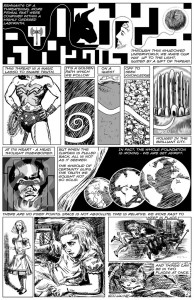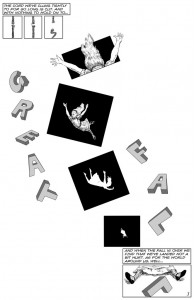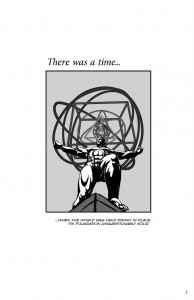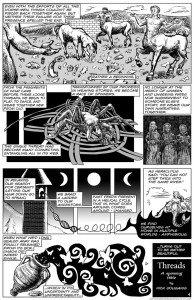This work was created for Dr. Ruth Vinz’s course on Postmodern Textual Practices. We were asked to draft a postmodern take on a fairy tale or myth. At the same time we’d been mapping out our definition of what postmodernism means. Mine includes a lot of developments in science and mathematics and music – sampling and DJ culture. (Wrote an essay on this back in my Detroit days: http://www.thedetroiter.com/JUN03/ArtCut.html). Anyhow, this riffs on my method of spin, weave, and cut, and takes that approach to discuss modernism and the turn to the postmodern through myths, fairy tales, and similar literature all “mashed up” with philosophical and scientific notions. Often given the referential nature of my work, I feel like providing a key to all the imagery. (I did this once with the Rabbit page from Possibilities (though note, the key is not provided on the website, sorry…) Due to just how much is pulled in for this one, I felt it would be fun to do so, show my hand and offer the equivalent of footnotes, or perhaps hyperlinks. So if you’re interested at looking behind the curtain – check it out below the comic itself. – Nick


Threads – the Key
Page 1: A single panel on an otherwise empty page!? Shocking for someone who likes to cram nearly everything he can in a 6.5 by 10in space. Was pleased to experiment with that and the similar emptiness of page three provide breaks between the more jammed even pages. The opening line is my take on “once upon a time…” The image is Atlas, specifically referencing Lee Lawrie’s statue at Lincoln Center. The “world” is partially a reference to the statue itself but also to Kepler’s sketch of the nested Platonic solids. I’d wanted to work in those rigid forms to accompany the text and this mashup allowed for that.
Page 2:
Panel 1: Greek myths are full of stories of locking away the primal, irrational, and chaotic in Tartarus (as with the Titans) or as this panel references – in the Labyrinth. Labyrinth imagery makes its way into a number of my pieces – as the double axe (also seen here) has come to be connected to butterfly and metamorphosis. (See A Conversation with Charles, Maxine Says, and A Cosmology of Ideas V2, for instance.) I pull some of my thinking here from Michael Ayrton’s “Maze Maker,” a novel about the creative process, as told through the story of Daedalus, the builder of the labyrinth and father of Icarus. The Minotaur is seen less as a monster in its own right but as some primal aspect of ourselves necessary to keep down in order to seek a more rational life. Theseus follows Ariadne’s thread up into the light, and my text is also meant to hint at Plato’s story of the shadows in the cave and escaping to enlightenment (here, the radiating ball of string.)
P2: Wonder Woman, and her lasso of truth. In the Bi(Bli)ography piece, through a coincidental juxtaposition in my layout, I started thinking about the connection between Ariadne’s thread, Wonder Woman’s Lasso, and the Yellow Brick Road as golden paths toward truth. That thread ended up becoming a partial genesis for this piece.
P2-5: Yellow Brick Road – a quest for knowledge, for heart, home, and bravery.
P6: The text is a reference to Descartes’ split between mind and body.
P7: Continental Drift Theory had a huge impact on how we think of the world and I sought to depict that here with images of earth as Pangae, Gondwana, and today’s configuration of the continents. (Also placing them as I did is also a reference to the way multiple earths are depicted in DC Comics’ “Crisis on Infinite Earths” for those keeping score at home.)
P8-11: “No fixed points in space” is a quote from Einstein picked up by Merce Cunningham as part of his approach to dance. Moving fast to keep in place is a nearly direct quote from Through the Looking Glass. The Cheshire Cat is joined with Schrodinger’s cat – and the idea of superposition. This would’ve been fun to explore more, and Alice’s cat playing with a ball of string almost made its way in (only the string stayed in back up at Panel 1.)
Page 3: When the cord is cut, literally, I wanted to show our perspective falling like Alice down the Rabbit Hole. However I was concerned with how to bring the reader back up after a strong vertical sequence (which I was less than successful in doing in A Cosmology of Ideas V2), so I opted to give it its own page. This then left me with an odd number of pages, which for printing purposes I’m not a fan of, and so I opted to shift the proposed Atlas panel onto its own page – which I think gave it greater impact than it would have had as a tiny panel alongside the others. The fall not only references Alice’s fall, but the Great Fall text is a reference to Humpty Dumpty’s fall, which we’ll see the effects of on the next page.
Page 4:
Panel 1: Arriving on the scene to fix up Humpty Dumpty after his fall from the wall, are all the King’s Horse-Men. Having already decided to use a Spider-woman and a Mermaid in the piece, this compression of all the King’s horses and all the King’s men into one worked well. Plus I got to draw centaurs, which are really weird. Furthermore, I mashed this story with the Four Horsemen of the apocalypse, whose appearance here doesn’t spell the end. A hint that our fears from the beginning of things to lock away, might have been a bit rash.
P2: I’ve referenced Arachne before in Maxine Says, and given the threaded nature of this she was one of the few players I had in mind from the beginning. (Spiderman stayed out of it…) I saw Athena’s punishment as being seen as a gift instead, one of a number of reversals of perspective in the piece. “Fabric of relations” comes from Lyotard’s text on the Postmodern Condition. The image draws on Gustav Dore’s rendering of her in Dante’s Purgatorio.
P3: We see the Three Fates, the Grey Women, or Moirae – maiden, matron, and crone. Those who spin, measure, and cut the thread that is our lives (and for whom my website and method draws its name.) Neil Gaiman used them a lot in the Sandman and that serves as a big influence in using them here. Depending on where you read – their sight is ambiguous. Destiny or fate is often seen as blind, so while some accounts say that they share one eye between them, I went with the blind depiction here.
P4: Rapunzel lets down her hair – a braid of DNA connecting us to our past, as postmodern methods cut up samples of past works to make new. I touch on similar stuff (in terms of “cleaving”) in both versions of Cosmology of Ideas. The cycle of the moon also references the symbolism for the Three Fates – waxing, full, and waning, as the DNA becomes a coiled spiral, becomes waves – tides caused by the moon above. (Had hoped to do more with that connection – but not here.) The text borrows heavily from Ayrton’s Maze Maker: “Life is not a circle but a helix.” Worked well with the imagery that was already emerging, and liked the idea that the past doesn’t come full circle but a cycle of a different sort.
P5: Heraclitus’ words connect to the panel previous of past feeding present and the final panel on Chaos, as the Little Mermaid speaks to the merged creatures we’ve become, necessary for a world that’s constantly shifting.
P6: As this developed, it turned out for the most part I was working with stories featuring women – even when Theseus is depicted, it’s Ariadne that saves the day. Keeping with that, I read up on Pandora who seems to have gotten a bad rap. Her name properly translated means “all-giving” and the “box” actually means a jar of sorts. I used the image of a jar and hoped by referencing box in the text that the connection was clear. I wanted to connect what’s in the jar/box back to thing locked away in the Labyrinth, and in taking a different look at Pandora, take a different look at Chaos theory as well. And so what comes out is the fluid, nonlinear stuff that makes this world, and butterflies – symbols of metamorphosis and the butterfly effect – or a sensitive dependence on initial conditions. Even the smallest of things has an effect on connected systems. I think it’s a beautiful thought, and from the physics referenced by Alice to Chaos theory here, all of the narrative speaks to a world shrugging off a search for certainty and perhaps embracing complexity as complexity. – N




